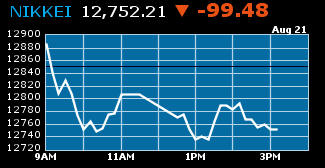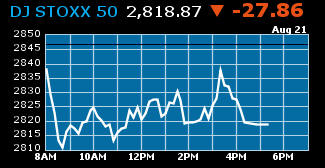|
Econ 223
PERSONAL FINANCE
Assignment 10
( 5 PM on Sunday, November 21)
Purpose: Determine the asset allocation you would recommend for your prototype family and exactly how you would implement that asset allocation. Your work for this assignment will include additions to your Master Spreadsheet (“Asset Allocation” worksheet), as well as a separate write-up.
Resources: Witte & Gulley Investing III-V presentations, "Asset Allocation" worksheet, Swensen (2005), Authers (2010) and Febo & Witte’s “Econ 223Morningstar”.
This assignment asks you to: (1) determine the asset allocation that you would recommend for your family; (2) explain why you recommend that asset allocation; (3) explain exactly what investment vehicles you would use to implement the recommended asset allocation (e.g., identifying specific fixed income, equity and other investment purchases you would make, such as Vanguard Prime Money Market (symbol VMMXX), iShares Russell 3000 Index Fund (symbol IWV), U.S. T-Bills/Notes/TIPS at auction, ETFs (specify which and symbol), CDs, etc.) and (4) decide upon a price that you would be willing to pay for each asset that you do not purchase in the primary market.
Begin by downloading “Net Worth & Asset Allocation Template Assn 10” worksheet template from the Prototype folder. We have added 3 columns to the Asset Allocation worksheet, but have made no other changes. Two of the new columns, entitled "Asset Location" allow you to explicitly show into what type of accounts you would place various assets. The third new column, entitled "Desired Purchase Price" lets you indicate the price at which you would like to purchase the assets you have chosen to implement your allocation if you do not plan to purchase them in the primary market. This would be the limit price that you would use when placing an order to purchase in the secondary market. Copy the three new columns into your Asset Allocation worksheet.
Next, if your
prototype has less than $100,000 in Asset Holding (cell B42), make up a story
as to how your prototype received a $100,000 windfall to invest. In cell G41,
add $100,000 to the amount in cell B41. This is the amount that you will be
investing.
Recommended Asset Allocation & Asset Location
In Column E (and Column F if your prototype owns a home) of your "Asset Allocation" worksheet, titled “Recommended Asset Allocation (%)”, record the asset allocations that you recommend for your family (% of total assets that your recommend your prototype should invest in the various asset classes). Based on your recommended asset allocation (Column E), fill in Column G with the actual $ Amount you are designating for each asset class. Explain briefly (a couple of paragraphs), why you recommend the asset allocation that you have recorded in columns E or column F for your family. You should cite material from Swensen and Authers that influenced your recommended asset allocation.
In Columns H & I, indicate what $ amount of your total $ allocation to each asset class (given in Column G) you will be put in tax-deferred accounts & in taxable accounts. Remember that your choice of investments for 401(k) funds will be restricted to those your employer makes available.
Note: the sum of Columns H & Columns I has to equal the $ amount in Column G. Also the total amount of money that you have available in tax-deferred accounts may not be large enough to allow you to allocate all assets that you would like to tax-deferred accounts.
Implementing the Recommended Asset Allocation
In the column labeled "Method of Implementation", indicate exactly what assets your family will own to obtain the asset allocation that you recommend. Be explicit. Explain briefly in your write-up why you chose the assets that you did to achieve the asset allocation.
For example, our explicit asset recommendations for the Single LA Nurse (Prototype #4 Upper Middle Class Single Woman) would be as follows: We would recommend that she open a Brokerage Account and a Mutual Fund account at Vanguard. The Mutual Fund account will contain CA Tax Exempt Money Market fund (symbol VCTXX) which will serve both as a back up transaction account & the "sweep account" (account from which she buys such things as non-Vanguard Mutual funds, ETFs & individual fixed income assets) for her Brokerage account. We recommend that she put $3000 of the $5100 she is holding in cash in this money market account. (Note: she can write checks on this account as long as the checks are for $250 or more & hence it can serve as an interest earning backup transaction account.) To obtain her exposure to municipal bonds, we recommend that she purchase $25,000 of Vanguard's CA Intermediate-Term, Tax-Exempt Investor Fund (symbol VCAIX) which will reside in her Vanguard Mutual Fund account. For inflation protection, we recommend that she purchase $32,000 of Vanguard Inflation-Protected Securities Fund Investor Shares (symbol VIPSX). For US equity exposure, we recommend that she purchase $38,000 of iShares Russell 3000 ETF Index Fund (symbol IWV) and for her "Other Developed Equity" exposure, we recommend that she purchase $7000 of iShares MSCI EAFE ETF Index (symbol EFA).These ETFs & any other assets that she buys that are not Vanguard mutual funds will reside in her Vanguard brokerage account.
Set a Desired Purchase Price for the assets your chose in Column K. You can obtain this price by looking at the way in which the price of the asset has changed over the last 3 to 5 years & by reading Morningstar's estimate of fair value of the assets (only available for ETFs & equities). Remember that you do not want to buy near a high or sell near a low. Explain how you set one Desired Purchase Price in your write up.
For example, to set a Desired Purchase Price for VIPSX, we went to https://personal.vanguard.com/us/home and clicked on the “Research Funds & Stocks” tab. We clicked on the sub tab “Vanguard Funds” and entered VIPSX. We next clicked on the tab “Price & Performance”. To the left below “Historical Prices”, we clicked on “Search for More Historical Price Information”. We then got the high and low prices for 2010, 2009 and 2008. We noted that the highest price for VIPSX was over $13 per share for each of these years. The lowest price was $12.45 in 2010, $11.33 in 2009 and $10.77 in 2008. Given this information, we set our Desired Purchase Price for VIPSX at between $12 & $12.50. Such a price will provide a real yield of between 1% & 1 1/2% & is in the realm of this year’s trading prices. The yield is lower than we would normally want (in the fall of 2008 the real yield for this fund was 3%), but this is the environment that we are currently in. We would use Vanguard’s “Alert Messaging” system (at https://personal.vanguard.com/us/whatweoffer/stocksbondscds/buy-sell-stock) so that we would be alerted when VIPSX fell to $12.50.
Upload your write-up with answers to the above questions and your master prototype spreadsheet that contains your completed “Asset Allocation” worksheet to the Assignment 10 folder in the Econ223-Drop conference in FirstClass before 5PM on Sunday, November 21.
Home Outline &Readings Description Assignments Requirements
- Ann Witte, AWitte@Wellesley.edu
- Economics
- Date Created: October 22, 2006
- Last Modified: November 13, 2010
- Expires: January 15, 2011
© Ann Dryden Witte 2006


